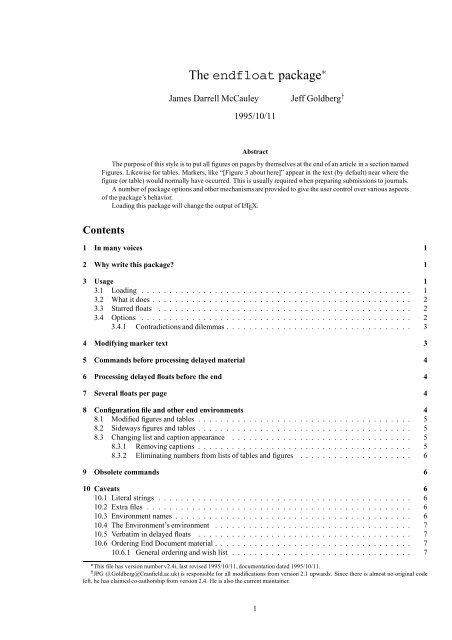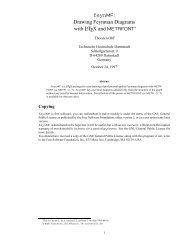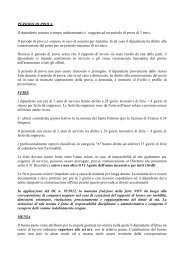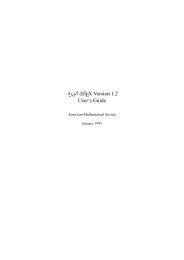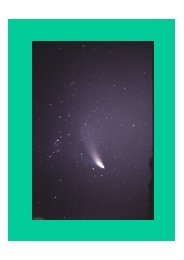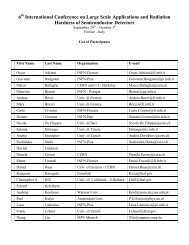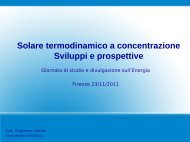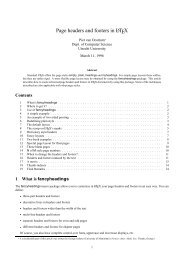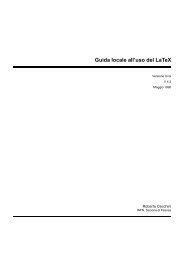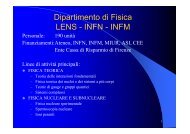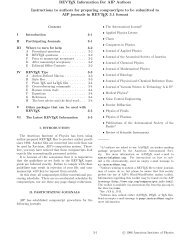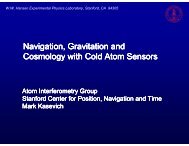The endfloat package - INFN
The endfloat package - INFN
The endfloat package - INFN
Create successful ePaper yourself
Turn your PDF publications into a flip-book with our unique Google optimized e-Paper software.
<strong>The</strong> <strong>endfloat</strong> <strong>package</strong> <br />
James Darrell McCauley<br />
Jeff Goldberg y<br />
1995/10/11<br />
Abstract<br />
<strong>The</strong> purpose of this style is to put all figures on pages by themselves at the end of an article in a section named<br />
Figures. Likewise for tables. Markers, like “[Figure 3 about here]” appear in the text (by default) near where the<br />
figure (or table) would normally have occurred. This is usually required when preparing submissions to journals.<br />
A number of <strong>package</strong> options and other mechanisms are provided to give the user control over various aspects<br />
of the <strong>package</strong>’s behavior.<br />
Loading this <strong>package</strong> will change the output of L A TEX.<br />
Contents<br />
1 In many voices 1<br />
2 Why write this <strong>package</strong>? 1<br />
3 Usage 1<br />
3.1 Loading................................................ 1<br />
3.2 Whatitdoes.............................................. 2<br />
3.3 Starredfloats ............................................. 2<br />
3.4 Options ................................................ 2<br />
3.4.1 Contradictionsanddilemmas................................. 3<br />
4 Modifying marker text 3<br />
5 Commands before processing delayed material 4<br />
6 Processing delayed floats before the end 4<br />
7 Several floats per page 4<br />
8 Configuration file and other end environments 4<br />
8.1 Modifiedfiguresandtables...................................... 5<br />
8.2 Sidewaysfiguresandtables...................................... 5<br />
8.3 Changinglistandcaptionappearance ................................ 5<br />
8.3.1 Removingcaptions...................................... 5<br />
8.3.2 Eliminatingnumbersfromlistsoftablesandfigures .................... 6<br />
9 Obsolete commands 6<br />
10 Caveats 6<br />
10.1Literalstrings............................................. 6<br />
10.2Extrafiles............................................... 6<br />
10.3Environmentnames.......................................... 6<br />
10.4<strong>The</strong>Environment’senvironment ................................... 7<br />
10.5Verbatimindelayedfloats ...................................... 7<br />
10.6OrderingEndDocumentmaterial................................... 7<br />
10.6.1 Generalorderingandwishlist................................ 7<br />
<br />
This file has version number v2.4i, last revised 1995/10/11, documentation dated 1995/10/11.<br />
y<br />
JPG (J.Goldberg@Cranfield.ac.uk) is responsible for all modifications from version 2.1 upwards. Since there is almost no original code<br />
left, he has claimed co-authorship from version 2.4. He is also the current maintainer.<br />
1
10.7Whatare<strong>package</strong>sfor?........................................ 8<br />
10.8 Float position specifiers . . ...................................... 8<br />
10.9 Misplaced headers .......................................... 8<br />
10.10Known incompatibilities . ...................................... 8<br />
10.10.1Environmentnames...................................... 8<br />
10.10.2Orderingendmaterial .................................... 8<br />
10.10.3 Conflicting \enddocument ................................ 9<br />
10.10.4Miscellaneous ........................................ 9<br />
11 Support 9<br />
12 History 9<br />
12.1<strong>The</strong>burdenofhistory......................................... 9<br />
12.2Author................................................. 9<br />
12.3Version2.4 .............................................. 9<br />
12.4Version2.3 .............................................. 10<br />
12.5Version2.2 .............................................. 10<br />
12.5.1 Packageoptions ....................................... 10<br />
12.5.2 Internalcommands...................................... 10<br />
12.5.3 Documentation........................................ 10<br />
12.6Version2.1 .............................................. 10<br />
12.7Minorchanges(version2.0) ..................................... 11<br />
12.8 Brian Junker’s modifications (version 2.0) .............................. 11<br />
13 Wish list 11<br />
1 In many voices<br />
This documentation was put in its current form by Jeff Goldberg, who has tried to indicate when he is (when I<br />
am) speaking. See section 12 for more detail. However, both the original author, Darrell McCauley, and a major<br />
contributor, Brian Junker, use the first person singular. In this version I no longer work to keep it clear who wrote<br />
what portions of the documentation and the code, but have allowed things to blend together a little more, since<br />
the constant interpolations were hindering readability. Generally the user documentation was written by Darrell<br />
MaCauley (jdm), but anything that refers to L A TEX2 " features was added by me (jpg). Also, where you find spelling<br />
and typographical errors, you are likely to be reading my text.<br />
This documentation is long. Most users won’t need to read beyond the first few pages, but there are a number of<br />
ways to customize the behavior of <strong>endfloat</strong> and these are detailed as the documentation progresses. <strong>The</strong> <strong>package</strong><br />
is unusual in the way it does its job, so it can interact with other <strong>package</strong>s and other aspects of L A TEX inwaysthat<br />
may be surprising. Although the <strong>package</strong> is flexible in some respects, it is highly limited in others. Tools and hints<br />
are provided to help you control these interactions, but these do require some reading. But you only need to take a<br />
look at these sections when the need arises.<br />
2 Why write this <strong>package</strong>?<br />
Many journals require tables and figures to be separated from the text when you submit those ugly double spaced<br />
copies. <strong>The</strong>y also usually want a list of figures/tables before these sections (capability added in v2.0, control<br />
through <strong>package</strong> options added in v2.2).<br />
I (jdm) am writing a set of styles that look exactly like a journal, but just by adding one style option, I wanted<br />
the user to meet the requirements for formatting submissions. I encourage others to do the same. 1<br />
3 Usage<br />
3.1 Loading<br />
Just include the <strong>package</strong> in your preamble<br />
1 Note that jdm, working in old LATEX209 did not have the distinction between class, <strong>package</strong> and <strong>package</strong> options available to him at the<br />
time he made his comment. <strong>The</strong> most coherent way to do what is needed is to use a class, let’s say submit, which would load <strong>endfloat</strong> and<br />
presumably some double spacing <strong>package</strong>s among other things. Once that class is defined, then other classes which are specific to particular<br />
journals can be defined.<br />
2
Table 1: Options and defaults<br />
Option Default Default implication Descriptions<br />
nofiglist off no list of figures<br />
notablist off no list of tables<br />
nolists nofiglist, notablist neither list<br />
figlist on list of figures<br />
tablist on list of tables<br />
lists figlist, tablist list of tables and figures<br />
nofighead on no ‘Figures’ section header<br />
notabhead on no ‘Tables’ section header<br />
noheads nofighead, notabhead neither of the headers<br />
fighead off ‘Figures’ section header<br />
tabhead off ‘tables’ section header<br />
heads fighead, tabhead Both section headers<br />
markers on Place markers in the text<br />
nomarkers off no markers in text<br />
tablesfirst off Put tables before figures<br />
figuresfirst on Put figures before tables<br />
\use<strong>package</strong>[...]{<strong>endfloat</strong>}<br />
Note that versions 2.1 and beyond will no longer work with L A TEX209. Get your administrator to upgrade your<br />
site to the new standard, L A TEX2 " . Although version 2.0 (a L A TEX209 version) will usually work with L A TEX2 " ,it<br />
will not do so in combination with certain other <strong>package</strong>s.<br />
3.2 What it does<br />
Merely loading the <strong>package</strong> will get it working. Loading it will have L A TEX produce two extra files with .ttt and<br />
.fff extensions (for tables and figures, respectively).<br />
This puts all figures and tables at the end of your document each on a page by itself 2 and creates a List of<br />
Figures and/or List of Tables section at the end (when appropriate and controllable by options). <strong>The</strong> floats are<br />
processed using \baselinestretch{1} irrespective of what is used in the document as a whole. This can be<br />
reset to, say 1.4, by using<br />
\AtBeginDelayedFloats{\renewcommand{\baselinestretch}{1.4}}<br />
which is available from version 2.4. See section 5 for more discussion.<br />
It also leaves notes in the text (i.e., “[Figure 4 about here.]”). If you would rather not have these, this can be<br />
turned off by using the nomarkers options. If you do not like the look of this marker, you can change their text<br />
and appearance (see section 4).<br />
3.3 Starred floats<br />
<strong>The</strong> figure* and table* versions are supported by the current version. 3 However, it must be noted that what<br />
actually gets processed at the end is always with the star, since in single column mode the * is harmless.<br />
3.4 Options<br />
Under version 2.2 and higher, the <strong>endfloat</strong> <strong>package</strong> uses <strong>package</strong> options. <strong>The</strong> options are summarized in table 1.<br />
In addition to these options, see sections 8 and 5 for more advanced ways of controlling output.<br />
<strong>The</strong> list of tables and figures can be suppressed by using the nofiglist and notablist options. Both can<br />
be suppressed with the nolists option. 4 <strong>The</strong> default is lists.<br />
A section header for ‘Tables’ and ‘Figures’ can be produced by using the option tabhead, fighead, respectively,<br />
and heads for both. <strong>The</strong> defaults are notabhead and nofighead.<br />
If you want the headers instead of the lists you would need to use both the nolists and the heads options.<br />
2 This is the default. See section 7 to see how to have multiple floats per page.<br />
3 I (jpg) very stupidly introduced a bug in version 2.2 which wrecked figure*. It has been brought to my attention and fixed. I offer my<br />
thanks and my apologies.<br />
4 In versions prior to 2.2 the command for turning of the lists turned on the headers (the equivalent of the heads option). That is not the<br />
case with these options. <strong>The</strong> lists and the heads options are entirely orthogonal.<br />
3
If you want to suppress the markers in the text, use the option nomarkers. <strong>The</strong> default is markers.<br />
Normally the figures at the end appear before the tables. This can be changed by using the option<br />
tablesfirst. <strong>The</strong> default is figuresfirst. 5<br />
A typical usage might be something like<br />
\documentclass[a4paper,12pt]{article}<br />
\use<strong>package</strong>[nolists,tablesfirst]{<strong>endfloat</strong>}<br />
...<br />
\begin{document}<br />
which would suppress the list of tables and figures as well as the corresponding section headers, and would have<br />
the tables precede the figures.<br />
3.4.1 Contradictions and dilemmas<br />
It is not recommended that one specify conflicting options, but if you insist, here are the rules. In table 1 the third<br />
column indicates what other options are implied by default. That is heads turns on fighead by default, but that<br />
implication can be overruled by explicitly stating the nofighead option.<br />
1. When two entirely conflicting options are both specified the one corresponding to the default wins. (e.g., if<br />
both markers and nomarkers are specified then markers will be in effect). Here the notion of default<br />
is determined by inspecting the second column of table 1.<br />
2. When one option is more specific than the other the more specific one holds true, and the more general<br />
will only partially hold. So specifying fighead and noheads will be the same as saying fighead and<br />
notabhead.<br />
3. <strong>The</strong> order in which the options appear is not relevant.<br />
4. If some of the obsolete commands for these options are used all bets are off on these interactions.<br />
4 Modifying marker text<br />
\tableplace<br />
\figureplace<br />
Announcements in any language can be generated by using \renewcommand to redefine \tableplace and<br />
\figureplace<br />
<strong>The</strong> defaults are<br />
\newcommand{\figureplace}{%<br />
\begin{center}<br />
[\figurename˜\thepostfig\ about here.]<br />
\end{center}}<br />
\newcommand{\tableplace}{%<br />
\begin{center}<br />
[\tablename˜\theposttbl\ about here.]<br />
\end{center}}<br />
<strong>The</strong>se redefinitions may be placed in the <strong>endfloat</strong>.cfg file (see section 8 for more information).<br />
WARNING! <strong>The</strong> name of the counters posttbl and postfig are very likely to change in future versions,<br />
possibly to efloattttctr and efloatfffctr, but whatever they change to, the names will be a function of<br />
either the file extension names ttt or fff, or the environment names table and figure. <strong>The</strong> purpose is so<br />
that the counters can be automatically created for new float types.<br />
Hooks for the babel <strong>package</strong> are not (yet) provided, so you will have to do things by hand:<br />
\renewcommand{\figurename}{Abra} % if no babel<br />
\renewcommand{\figureplace}{%<br />
\begin{center}<br />
[A(z) \thepostfig.˜\figurename itt legyen.]<br />
\end{center}}<br />
If you wish to change the name of the figure or table section heading, you can to that in the usual way (via the<br />
babel <strong>package</strong>, or by redefining \figuresection and tablesection directly).<br />
4
5 Commands before processing delayed material<br />
\AtBeginFigures<br />
\AtBeginTables<br />
BeginDelayedFloats<br />
If you wish to have some more control over how the tables and figures are processed, you can make<br />
use of the commands \AtBeginDelayedFloats, \AtBeginFigures and \AtBeginTables. If<br />
you wanted to ensure that the tables begin on a recto page, you could for example say something like<br />
\AtBeginTables{\cleardoublepage}in the preamble of your document. 6 Material in \AtBeginTables<br />
and \AtBeginFigures is processed after the list of tables or list of figures (if those options are set) and just<br />
before the files with the delayed material in input. <strong>The</strong>se are also processed after the original definitions of the<br />
table and figure environments are restored.<br />
<strong>The</strong>se commands can be used either in the preamble of your document, or in the <strong>endfloat</strong>.cfg file (see<br />
section 8).<br />
6 Processing delayed floats before the end<br />
ocessdelayedfloats<br />
If you wish to process the floats prior to the end of the document, you may do so with the \processdelayedfloats<br />
command, which has been made available from version 2.4 onward. This will process all of the unprocessed tables<br />
and figures up to that point. You may wish to use this command at the end of every chapter for example.<br />
If you do use this, there are several points which should be noted.<br />
1. All outstanding floats will be processed at the end of the document.<br />
2. If you use the lists option you will get a list of all tables and figures in the document. Not just the ones<br />
for the current chapter. Using lists may have other odd consequences.<br />
3. It is your responsibility to set \tableplace and \figureplace correctly, as well as to possibly reset<br />
the counters \theposttbl and \thepostfig (section 4) as you wish. If you do not reset them, they<br />
will continue to increase throughout the document.<br />
7 Several floats per page<br />
\efloatseparator<br />
Endfloat places \efloatseparator after each float in their respective files. By default it is defined to<br />
be \clearpage forcing one float per page. You may change this by using \renewcommand to redefine<br />
\efloatseparator as you wish. One possibility, suggested by a user, is<br />
\renewcommand{\efloatseparator}{\mbox{}}<br />
It makes most sense to place such a redefinition in the configuration file (see section 8).<br />
Do not be mislead by my misleading name for this command. This actually appears after each float including<br />
the last one, so is not truly a separator.<br />
8 Configuration file and other end environments<br />
Many users have suggested options to the <strong>package</strong> which are often journal specific. Many of the suggestion options<br />
are also not specific to how <strong>endfloat</strong> itself works, but to how captions and lists of figures and tables are to appear.<br />
Instead of burdening the <strong>package</strong> with options that, in the end, are specific to particular journals, I have added a<br />
configuration file for <strong>endfloat</strong> which will allow you to make many of these redefinitions without having to further<br />
increase the size of <strong>endfloat</strong> itself.<br />
As of version 2.4 <strong>endfloat</strong> will look for a file called <strong>endfloat</strong>.cfg in TEX’s input path. If it is found, it will<br />
be included after <strong>endfloat</strong> is loaded. <strong>The</strong> purpose of this configuration file is to allow the user to include additional<br />
definitions related to <strong>endfloat</strong>. For example, any redefinition of \figureplace can go in this file, so that the<br />
preamble does not need to be filled with material that only makes sense when <strong>endfloat</strong> is loaded. 7<br />
5 It is hoped that future versions will allow new kinds of float or environment to be delayed, in which case an entirely new mechanism will<br />
need to be introduced for ordering their appearance.<br />
6 It is difficult for me to imagine a situation where one would be using <strong>endfloat</strong> and the class option twoside, without which<br />
\cleardoublepage is the same as \clearpage, together. Another, more realistic example would be to adjust the \baselinestretch<br />
for table and figure processing.<br />
7 However, if you find yourself placing other material (such as double spacing or modification of title page and abstract) into<br />
<strong>endfloat</strong>.cfg to simulate a journal submission class, you should really do the right thing and create a journal submission class. Creating<br />
a minor class (one that loads an existing class such as article is not difficult. See the Class Guide[3] for instructions. Future versions of<br />
the <strong>endfloat</strong> documentation may include a sample.<br />
5
<strong>The</strong> configuration file can also provided so that the user could specify environments other than figure and<br />
table (and their *-ed counterparts) which can be delayed until the end of the document. At the moment that<br />
would be very difficult to do with environments which are not processed with tables of figures (ie, those environments<br />
that should have a different “list-of”, different counters, and different temporary files from those used by<br />
tables and figures); but the plan is to make even that ever more easier.<br />
8.1 Modified figures and tables<br />
As stated in section 10.3, <strong>endfloat</strong> will utterly fail if one does something like<br />
\newenvironment{foo}{...\begin{table}...}<br />
{...\end{table}...}<br />
because <strong>endfloat</strong> will make \begin{table} go into a verbatim like mode and look for the literal string<br />
\end{table}, which it will not see in \end{foo}.<br />
However, for those who know L A TEX internals fairly well, it is not impossible to tell <strong>endfloat</strong> to also treat the<br />
foo environment as a delayed table. It is however, not easy, although my goal is to make this easier in subsequent<br />
versions. It will take a fair amount of understanding of the implementation to see how to do this. And the best<br />
thing to do is to follow an example.<br />
8.2 Sideways figures and tables<br />
<strong>The</strong> rotating <strong>package</strong>[5] contains definitions of environments sidewaysfigure and sidewaystable, 8 and<br />
it would be nice to have these work in documents which also use <strong>endfloat</strong>. Appropriate redefinitions of these so<br />
that they work with <strong>endfloat</strong> are given in the file efxmpl.cfg. If you wish to use that file, you should include it<br />
as a <strong>package</strong> (possibly renamed) after you include <strong>endfloat</strong>. Or you could simple rename it to <strong>endfloat</strong>.cfg<br />
and <strong>endfloat</strong> will include it automatically.<br />
For a description of those commands see section ??.<br />
8.3 Changing the appearence of “lists of” and captions<br />
When the lists option is used, the L A TEX commands \listoftables and \listoffigures are called.<br />
<strong>The</strong>se produce lists indicating the page number that each table or figure appear on. With <strong>endfloat</strong> in use this<br />
information is usually superfluous, and – rumor has it – undesirable by at least some journals. What seems to be<br />
required when using lists is that either the list does not the figure or table number, and/or the caption doesn’t not<br />
contain the caption text.<br />
This section provides a few rudimentary samples of what you might put into the configuration file to get<br />
these effects. I have chosen not to make these <strong>package</strong> options, because they are often too journal specific. <strong>The</strong><br />
availability of the configuration file means that you can put this things there, and the differences between <strong>endfloat</strong><br />
using and non-<strong>endfloat</strong> using L A TEX source documents is minimal.<br />
8.3.1 Removing captions<br />
\@makecaption<br />
<strong>The</strong> simplest thing is to provide a simple redefinition of \@makecaption. You should model your redefinition<br />
after the one described in classes.dtx for your release of L A TEX instead of blindly following what is here.<br />
\@makecaption takes two arguments, the first will be something like “figure 3” and the second will be the<br />
caption text. We will simply ignore the second argument. Most of the tricky bit of the definition is about testing<br />
whether the caption is longer than a line. Since we will only be using the first argument, we can safely assume that<br />
the caption will fit on one line. 9 Your redefinition of \@makecaption may look like<br />
\renewcommand{\@makecaption}[2]{%<br />
\vskip\abovecaptionskip<br />
\hbox to \hsize{\hfil #1\hfil}%<br />
\vskip\belowcaptionskip}<br />
\caption<br />
This still leaves one problem. If you use<br />
\caption[short caption text]ffull caption textg<br />
8 <strong>The</strong>se require support from the dvi driver, such as dvips.<br />
9 If you have \figurename as something absurdly long or a very narrow \textwidth, then you will have to use a more complicated<br />
version.<br />
6
only the short caption text will ever appear in the list of tables or figures. <strong>The</strong> following redefinition of \caption<br />
will take care of that. First save the original definition of \caption<br />
\let\OrigCaption\caption<br />
\renewcommand{\caption}[2][X]{\OrigCaption[#2]{}}<br />
8.3.2 Eliminating numbers from lists of tables and figures<br />
This is a bit trickier, and I have heard that it doesn’t work with all versions of L A TEX2 " , but I am unwilling to<br />
reinstall and older version for debugging this. A user [get the name] suggested that page numbers be suppressed in<br />
the lists of figures and tables.<br />
\l@figure<br />
\l@table<br />
All this requires is a redefinition of \l@figure and \l@table which are defined in classes.txt. Alsosee<br />
section 2.4.1 of the Companion to see how these macros are called.<br />
<strong>The</strong> real only trick here is that \l@figure is defined to take two arguments, but the second is never used.<br />
<strong>The</strong> way it will be called will give it something like<br />
{\numberline {3} Caption of that figure}{85}<br />
as arguments, where the second argument is the page number. <strong>The</strong> \numberline command will make use of<br />
the L A TEX register \@tempdima for the width of the box containing the table or figure number. So we need to set<br />
that. <strong>The</strong> rest is pretty unsophisticated. You can, of course, modify it at will.<br />
\renewcommand*{\l@figure}[2]{%<br />
\setlength\@tempdima{2.3em}%<br />
\noindent\hspace*{1.5em}#1\hfil\newline }<br />
And for tables:<br />
\let\l@table\l@figure<br />
9 Obsolete commands<br />
Versions of the <strong>package</strong> prior to 2.2 had some commands which the user could specify in the preamble to do what<br />
some of the options do now. Although I would like to eventually remove those commands, they are documented in<br />
the Companion; so they will remain for quite some time.<br />
10 Caveats<br />
Some of the things that are listed here may be considered bugs, design errors, interactions to watch out for, or just<br />
the way life is sometimes. <strong>The</strong>y are, at least, a matter of concern, and you should watch out for them.<br />
10.1 Literal strings<br />
When floats are being read, L A TEX is in verbatim mode. Among other things, this means that the lines like<br />
\end{figure}<br />
must appear on lines by themselves without any whitespace before or after them. A complete reimplementation of<br />
the most difficult part of the <strong>package</strong> is required to fix this limitation, but it is among the distant goals I have.<br />
10.2 Extra files<br />
This creates two extra files: hjobnamei.fff and hjobnamei.ttt. Any files by those names in the current<br />
directory will be overwritten.<br />
10.3 Environment names<br />
Because of how the redefinitions of figure and table are actually implemented, it is crucial that these environment<br />
names be used. That is, you cannot simply define a new environment which calls figure or table since<br />
the former must look for the literal string<br />
\end{figure}<br />
7
in the document, while doing no expansion of control sequences. <strong>The</strong> latter does the same, but wants table<br />
instead of figure. This caution generally applies to all ‘verbatim-like’ environments<br />
Although I haven’t been able to confirm this yet, the L A TEX system ScientificWord 10 may automatically put<br />
floats inside a macro called \FFRAME. If so, I hope that either someone from ScientificWord or one of its users will<br />
create something for \FFRAME similarly to what I have done for \sidewaystable in the sample configuration<br />
file (section 8).<br />
Steps are slowly being taken to allow for new delayed environments to be added. That will be version 3, but I<br />
(jpg) still have a long way to go to get there. Each new minor release of the <strong>package</strong> includes few changes visible<br />
to the user, but may contain substantial internal changes to move the <strong>package</strong> in the desired direction. Version 2.4<br />
now contains a configuration file in which various things can be defined. See section 8 for more information.<br />
Once it does become easier to delay other environments, the word “float” may not be the best expression, since<br />
there will be no reason to expect that only floating environments are delayed.<br />
10.4 <strong>The</strong> Environment’s environment<br />
Because no TEX expansion is done while the material in these floats are read in, but is delayed until the floats are<br />
processed at the end of the document, it will be the state of TEX at the end which will matter. For example, a<br />
document with something like<br />
\newcommand{\XXX}{YYY}<br />
...<br />
\begin{table}<br />
...<br />
... \XXX ...<br />
...<br />
\end{table}<br />
...<br />
\renewcommand{\XXX}{ZZZ}<br />
...<br />
\end{document}<br />
will process the table with \XXX expanding to ZZZ.<br />
In any particular instance, the user can use either re-redefine \XXX before the end of document, or can reredefine<br />
it using on of the hooks, \AtBeginDelayedFloats, \AtBeginTables,or\AtBeginFigures,<br />
which are discussed in section 5.<br />
10.5 Verbatim in delayed floats<br />
<strong>The</strong>re should be no problem with verbatim text within a float unless that verbatim text contains an \end{figure}<br />
or \end{table} in a figure or table respectively. I don’t see a fix for this. All I can imagine is that you create<br />
a new delayed type which behaves exactly like figure (or table) (even writing \begin{figure} and<br />
\end{figure} to the .fff file. [mutatis mutandis for table]) In future versions, I may create a sample like<br />
this in the sample configuration file, but it is a low priority since the only time one would write such a figure or<br />
table would be in a document about L A TEX and it is difficult to imagine circumstances where a document about<br />
L A TEX would need to be subject to <strong>endfloat</strong>.<br />
10.6 Ordering End Document material<br />
Version 2.1 uses the L A TEX2 " directive \AtEndDocument. This makes it L A TEX2 " specific, but it means that it<br />
can be used with other <strong>package</strong>s that use that directive. Previous versions of <strong>endfloat</strong> redefined \enddocument.<br />
Now several <strong>package</strong>s or commands can add stuff at the ends of documents and still work together. This does<br />
mean that the order of loading <strong>package</strong>s can be important! If you use several <strong>package</strong>s that may use the<br />
\AtEndDocument directive and you get funny results, try loading them in a different order. It that doesn’t<br />
work, complain to the maintainer of the <strong>package</strong>s so that they will work out a way for the <strong>package</strong>s to interact<br />
correctly.<br />
10.6.1 General ordering and wish list<br />
I believe that the output of a L A TEX2 " run should be independent of the order in which <strong>package</strong> are loaded. It would<br />
be possible to set this up, but it would take coordination of all <strong>package</strong> writers who use \AtEndDocument.<br />
<strong>The</strong> actual call to \AtEndDocument would not occur during <strong>package</strong> loading, but some new command, like<br />
10 A registered trademark. Write to info@tcisoft.com for more information.<br />
8
\ExecuteAtEndDocument would be called by the user after all such <strong>package</strong>s are loaded, with tags for each<br />
thing in the <strong>package</strong>s, so something like<br />
\use<strong>package</strong>{lastpage}<br />
\use<strong>package</strong>{<strong>endfloat</strong>,xyzzy}<br />
\ExecuteAtEndDocument{<strong>endfloat</strong>,xyzzy,lastpage}<br />
and the order of End Document material would be the <strong>endfloat</strong> material, followed by xyzzy, and finally by<br />
lastpage. <strong>The</strong> <strong>package</strong> xyzzy is fictitious, while the <strong>package</strong> lastpage[1] exists, it doesn’t really matter what<br />
these do.<br />
I will have to wait until someone else develops such a system, but I will gladly modify the <strong>package</strong>s I am<br />
responsible for maintaining to comply with it. Until then I will include a message which begins with AED in every<br />
usage of \AtEndDocument, and try to minimize any side effects my usage may have.<br />
10.7 What are <strong>package</strong>s for?<br />
One option is to not have <strong>package</strong>s like <strong>endfloat</strong> actually call \AtEndDocument, but merely define a user level<br />
command which would make the call itself. This way, the order of those particular commands would matter, but<br />
not the ordering of the <strong>package</strong> loading.<br />
Another advantage of this is that <strong>package</strong>s could easily be things which make commands available, but do not<br />
actually entail a change in .dvi output themselves. It is classes, and options to classes which do that. That is, the<br />
actual loading of <strong>package</strong>s should have no visible effects, other than making new commands available. (Typeface<br />
changing <strong>package</strong>s, such as times, are obvious, and principled, exceptions.) <strong>The</strong> disadvantage is that it leads to<br />
two-step modifications (loading and calling) to change a document.<br />
I would propose any <strong>package</strong> (other than typeface changing <strong>package</strong>s) which changes output instead of merely<br />
providing additional commands, should be clearly labeled as doing such in the documentation and in a message.<br />
10.8 Float position specifiers<br />
Float position specifiers are passed to the temporary files and are used when those floats are processed. This may<br />
lead to funny results, especially if the first figure or first table uses [p] while the heads option is being used.<br />
This can lead to that float, floating to the page after the header. Most other float specifiers will not lead to any<br />
problems, because the <strong>package</strong> mucks about the various float specification parameters.<br />
10.9 Misplaced headers<br />
Version 2.2c contains a partial fix to a problem with the placement of floats around the section headers produced<br />
by the heads option. <strong>The</strong>re were two variants of the problem. In one the first float after the header would float<br />
above the header. This has been fixed by using the L A TEX2 " command \suppressfloats. <strong>The</strong> other problem<br />
is that that the first float may float to a page float after the page with the header on it.<br />
This has been partially fixed, but if users use the [p] specification on their first floats or if there are large<br />
floats, the problem can still show up. It is recommended that whenever the user wants a [p] that an [hp] be used<br />
instead. In normal running (without <strong>endfloat</strong>), this should only rarely effect the document, but it will help avoid<br />
the problem with the floating end float. An [h] may also be needed for large floats. <strong>The</strong>re is only need to be<br />
concerned about the first figure and first table.<br />
<strong>The</strong> natural solution to this problem will require that the bug in described in section 10.8 be resolved.<br />
10.10 Known incompatibilities<br />
Above I have outlined sources of potential conflicts and incompatibilities with other <strong>package</strong>s. Those sections contain<br />
a discussion of potential work-arounds. Here I list where I know of specific incompatibilities with distributed<br />
<strong>package</strong>s. This list is not complete. If you know on an addition, please let me know.<br />
10.10.1 Environment names<br />
<strong>The</strong> <strong>package</strong>s listed here all have the problem described in section 10.3. <strong>The</strong> work-arounds are also described<br />
there. rotating, Scientific Word.<br />
10.10.2 Ordering end material<br />
<strong>The</strong> following <strong>package</strong>s put things at the end of the document, and peculiar results are possible if you don’t pay<br />
attention to the order in which <strong>package</strong>s are loaded. This is described in section 10.6.1. <strong>The</strong> <strong>package</strong> lastpage is<br />
among these, as are recent versions of the <strong>package</strong> harvard.<br />
9
10.10.3 Conflicting \enddocument<br />
Prior to L A TEX2 " ’s provision of the hook \AtEndDocument, <strong>package</strong> writers were forced to redefine \enddocument.<br />
Some did so in ways that over wrote any other <strong>package</strong>’s redefinition of the same. When you encounter such a<br />
<strong>package</strong> you should try to get its author to release a modified version. Version 2.0 of <strong>endfloat</strong> was such a <strong>package</strong>s.<br />
So was the winter 1993 version of harvard (which has been fixed). But for those using an old version of harvard<br />
you will encounter problems.<br />
10.10.4 Miscellaneous<br />
<strong>The</strong>re are several other potential conflicts that don’t fall into the broader categories.<br />
<br />
<br />
\listoftables and \listoffigurers are left undefined in class elsart. But this is because Elsevier<br />
does not want those lists. Elsevier, bless them, does not want floats at the end for submissions to its journals.<br />
So there is no reason to use <strong>endfloat</strong> (with or without lists) with class elsart. Let’s hope that other publishers<br />
will follow Elsevier’s lead in understanding that the submission rules which were created were created for a<br />
reason, and when those reasons no longer apply, the rules should be changed.<br />
I look forward to the day when <strong>endfloat</strong> will serve no purpose.<br />
<strong>The</strong> float <strong>package</strong> appears to work in my limited tests. Although, only tables and figures get moved to end.<br />
<strong>The</strong> success is due to the robustness with which float is written.<br />
11 Support<br />
As is usual, this <strong>package</strong> is provided with no warranty whatsoever. However, it is my desire to make it useful and<br />
usable, although I may very well fail at that. If you need a feature added, see whether the hooks will allow you<br />
to do what you want. If something goes wrong look over section 10. But if you need to get in touch with the<br />
maintainer, you should send email to me at J.Goldberg@Cranfield.ac.uk.<br />
12 History<br />
12.1 <strong>The</strong> burden of history<br />
By version 2.2 the file was getting so that most of the bytes were things that had been commented out of previous<br />
versions, and changelog messages. Instead of this making things clearer to the maintainer, it turns out to be clutter.<br />
I (jpg) have started to throw out some of history (it is not really useful to see who corrected what typo or cleaned<br />
up what extraneous space with a % in 1991. Although my purge of history is far from complete, it should be noted<br />
that I do want to preserve the spirit of the history. I have already been miscredited with original authorship. I have<br />
made extensive modifications and extensions, but the basic core (even if only a small amount of version 2.0 code<br />
remains) and concept are JDM’s.<br />
12.2 Author<br />
<strong>The</strong> file was written by Darrell McCauley (jdm5548@diamond.tamu.edu) in February and March 1992. He acknowledges<br />
that much of the guts are adapted from comment.sty by Victor Eijkhout (eijkhout@csrd.uiuc.edu).<br />
So, although Jeff Goldberg (J.Goldberg@Cranfield.ac.uk) now maintains this, he should not be credited with writing<br />
the <strong>package</strong>, but only with extending and maintaining it. He has contributed enough so that by version 2.4 he<br />
claimed co-authorship.<br />
12.3 Version 2.4<br />
Version 2.4 involves the largest set of additional features since at least version 2.2 (which added all the options).<br />
Some of these are<br />
<br />
<br />
This version adds various user hooks, both as commands: \AtBeginFigures, \AtBeginTables,and<br />
\AtBeginDelayedFloats (section 5), and \efloatseparator (section 7).<br />
Most importantly, there is the addition of a configuration file (section 8). An example configuration file<br />
contains code which allows <strong>endfloat</strong> to work properly with the sidewaystable environment of the<br />
rotating <strong>package</strong>.<br />
10
Additionally, all figures and tables are written as figure* and table* in the temporary files, eliminating<br />
the need to force single column mode when table and figures are processed.<br />
<br />
<strong>The</strong>re are a fair number of internal changes to the code (which make it easier for the various hooks to work).<br />
<br />
Also changed some internal command names, such as \xtable, which did not include @ to names that to<br />
include @ such as \ef@extable. Also renamed all commands \end... to something else so as to not<br />
use up valuable environment name space.<br />
<br />
Removed dead code. It was making this too hard to read.<br />
Documentation changes to reflect user level changes. Also added more to the Caveats section (section 10).<br />
During the past few months I have received a wonderful level of feedback from users. Many made very useful<br />
suggestions. Even those queries which resulted from a misunderstanding of how to use the <strong>package</strong> have been lead<br />
me to modify the documentation. I had intended to acknowledge all of you, but the list has grown too long. You<br />
know who you are. Thanks, and good luck with your journal submissions!<br />
12.4 Version 2.3<br />
Very minor changes in the organization of some parts of the code, but I fixed a bug I introduced while “cleaning<br />
up” for for version 2.2: I had misunderstood part of the original code and commented out a necessary trick to allow<br />
for figure* <strong>The</strong> bug was very real, so I am releasing this version 2.3 as soon as I can document it, and am not<br />
waiting to include other planned improvements.<br />
12.5 Version 2.2<br />
A user (Kate Hedstrom) pointed out a number of bugs and shortcomings, which led me (jpg) to finally sit down<br />
and make some of the changes I had been planning on making. <strong>The</strong> effect of the tablesfirst option was<br />
specifically requested, and also work on the bug discussed in section 10.9. Although my bug fix is partial, version<br />
2.2 includes the means to suppress the headers altogether.<br />
12.5.1 Package options<br />
I, jpg, have used the <strong>package</strong> option facility of L A TEX2 " to get other options (described in section 3.4). I also made<br />
some cosmetic changes (breaking up lines to reduce the number of overfull boxes when printingthe documentation,<br />
line breaks and indentation to make the code more readable. I also replaced some \defs with \newcommands<br />
and \providecommands. This are not logged, because I actually found that all of the logging information was<br />
hampering my ability to read and modify the code.<br />
12.5.2 Internal commands<br />
In version 2.2, I also replaced some code internal to \xfigure and \xtable with \efloat@foundendfig<br />
and \efloat@foundendtab. This was merely a stylistic change.<br />
I also deleted some some definitions which are not used. <strong>The</strong>se had had probably been left as hooks, but with<br />
not enough for them to be useful hooks. <strong>The</strong>re are some cases where I have left these in when I could see what<br />
they could be used for. I have tried to add a note as to their potential use.<br />
12.5.3 Documentation<br />
Massive changes to user documentation, and some to the code documentation.<br />
12.6 Version 2.1<br />
I, Jeffrey Goldberg, in June 1994 wanted to use Darrell McCauley’s <strong>endfloat</strong>.sty with L A TEX2 " . It worked fine<br />
until I needed to use the L A TEX2 " directive \AtEndDocument for some other function, and discovered that it was<br />
not functioning and that it was because version 2.0 (and earlier) of endnotes.sty redefined \enddocument.<br />
<strong>The</strong> fix that I needed was trivial, but it made the file no longer compatible with L A TEX209. As a consequence, it<br />
seemed that the only way I could make up for this crime was to make it fully compatible with L A TEX2 " .<br />
11
12.7 Minor changes (version 2.0)<br />
A series of changes and fixes were made in March 1992. Many by the original author others by Ronald Kappert<br />
(R.Kappert@urc.kun.nl) who replaced literal strings with \figurename, and so on; and by schultz@unixg.ubc.ca<br />
who pointed out gobbling bug with \nomarkersintext.<br />
12.8 Brian Junker’s modifications (version 2.0)<br />
Brian Junker (brian@stat.cmu.edu) made a number of fixes. Here are his change comments:<br />
1. Changed “comment” to “figure” and “komment” to “table” throughout, to avoid collisions with other style<br />
files’ definitions of “comment”. Also fixes \begin{table} ends with \end{komment} error generated<br />
by my (older) version of PCTEX.<br />
2. Fixed gobble of float position specifiers. <strong>The</strong>re are two ways to do this:<br />
(a) \write\ifnextchar[{\gobbleuntilnext}{}into every environment written to \jobname.fff,<br />
etc.;<br />
(b) save L A TEX’solddef’sof\figure and \table and re-use them when processing fig’s and tables. I<br />
chose the latter approach, for maximum consistency with L A TEX, other style files, etc.<br />
3. Added def’s of \tablename and \figurename, whichmyversionofPC-TEX seemed to need. [backward<br />
compatibility for earlier versions —jdm]<br />
4. Moved formatting of figure and table markers to \figureplace and \tableplace.<br />
5. Style change: in-text markers are now centered reminders like “[Figure 4 about here.]”.<br />
6. Style change: added list of tables and figures to the table and figure sections. Change back to old format<br />
with \nofiglist and \notablist.<br />
7. Changed default to \markersintext.<br />
8. Fixed trivial typo in \@openposttbls<br />
All changes marked % bj at end of line. —Brian Junker (brian@stat.cmu.edu)<br />
13 Wish list<br />
I doubt that I will really work on this wish list in the near future but in addition to solving the know bugs, there are<br />
two major sorts of changes that I (jpg) would like to see.<br />
1. Updating the verbatim writing by using the tools in the verbatim standard <strong>package</strong>s, and the moreverb<br />
<strong>package</strong>. Since they provide more generalized an cleaner verbatim code then this which dates back to the<br />
earliest days of L A TEX.<br />
2. Integrate with the float <strong>package</strong> which (among other things) enables the user to define new floating environments.<br />
<strong>endfloat</strong> v2.2 only allows figures and tables to be placed at the end, not all types of potential<br />
floats. Nor does it allow the user to specify which of the two types it does recognize to be placed at the end.<br />
References<br />
[1] Jeffrey Goldberg. <strong>The</strong> lastpage <strong>package</strong>. Electronic documentation<br />
[2] Michel Goossens, Frank Mittelbach, and Alexander Samarin. <strong>The</strong> L A TEX Companion. Addison-Wesley, Reading,<br />
Massachusetts, 1994.<br />
[3] <strong>The</strong> L A TEX3 Project. L A TEX2 " for class and <strong>package</strong> writers (Preliminary draft) June 1994. Electronic Documentation<br />
[4] Anselm Lingnau. An Improved Environment for Floats June 1994 (version 1.2) Electronic Documentation<br />
[5] Sebastian Rahtz and Leonor Barroca. A style option for rotated objects in L A TEX April 1994. (version 2)<br />
Electronic Documentation<br />
12


